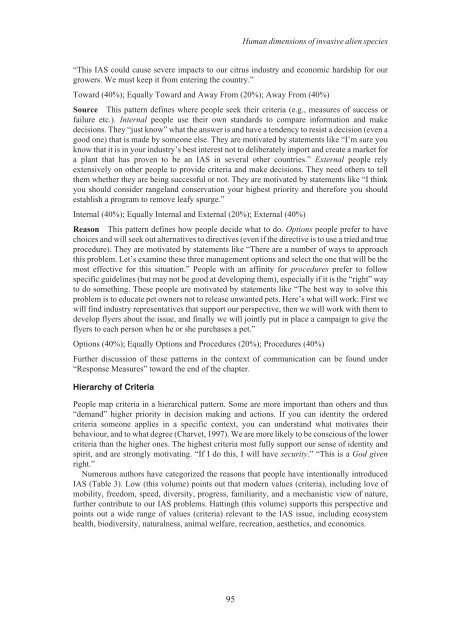Alien Species.vp - IUCN
Alien Species.vp - IUCN
Alien Species.vp - IUCN
You also want an ePaper? Increase the reach of your titles
YUMPU automatically turns print PDFs into web optimized ePapers that Google loves.
“This IAS could cause severe impacts to our citrus industry and economic hardship for our<br />
growers. We must keep it from entering the country.”<br />
Toward (40%); Equally Toward and Away From (20%); Away From (40%)<br />
Source This pattern defines where people seek their criteria (e.g., measures of success or<br />
failure etc.). Internal people use their own standards to compare information and make<br />
decisions. They “just know” what the answer is and have a tendency to resist a decision (even a<br />
good one) that is made by someone else. They are motivated by statements like “I’m sure you<br />
know that it is in your industry’s best interest not to deliberately import and create a market for<br />
a plant that has proven to be an IAS in several other countries.” External people rely<br />
extensively on other people to provide criteria and make decisions. They need others to tell<br />
them whether they are being successful or not. They are motivated by statements like “I think<br />
you should consider rangeland conservation your highest priority and therefore you should<br />
establish a program to remove leafy spurge.”<br />
Internal (40%); Equally Internal and External (20%); External (40%)<br />
Reason This pattern defines how people decide what to do. Options people prefer to have<br />
choices and will seek out alternatives to directives (even if the directive is to use a tried and true<br />
procedure). They are motivated by statements like “There are a number of ways to approach<br />
this problem. Let’s examine these three management options and select the one that will be the<br />
most effective for this situation.” People with an affinity for procedures prefer to follow<br />
specific guidelines (but may not be good at developing them), especially if it is the “right” way<br />
to do something. These people are motivated by statements like “The best way to solve this<br />
problem is to educate pet owners not to release unwanted pets. Here’s what will work: First we<br />
will find industry representatives that support our perspective, then we will work with them to<br />
develop flyers about the issue, and finally we will jointly put in place a campaign to give the<br />
flyers to each person when he or she purchases a pet.”<br />
Options (40%); Equally Options and Procedures (20%); Procedures (40%)<br />
Further discussion of these patterns in the context of communication can be found under<br />
“Response Measures” toward the end of the chapter.<br />
Hierarchy of Criteria<br />
People map criteria in a hierarchical pattern. Some are more important than others and thus<br />
“demand” higher priority in decision making and actions. If you can identity the ordered<br />
criteria someone applies in a specific context, you can understand what motivates their<br />
behaviour, and to what degree (Charvet, 1997). We are more likely to be conscious of the lower<br />
criteria than the higher ones. The highest criteria most fully support our sense of identity and<br />
spirit, and are strongly motivating. “If I do this, I will have security.” “This is a God given<br />
right.”<br />
Numerous authors have categorized the reasons that people have intentionally introduced<br />
IAS (Table 3). Low (this volume) points out that modern values (criteria), including love of<br />
mobility, freedom, speed, diversity, progress, familiarity, and a mechanistic view of nature,<br />
further contribute to our IAS problems. Hattingh (this volume) supports this perspective and<br />
points out a wide range of values (criteria) relevant to the IAS issue, including ecosystem<br />
health, biodiversity, naturalness, animal welfare, recreation, aesthetics, and economics.<br />
95<br />
Human dimensions of invasive alien species












